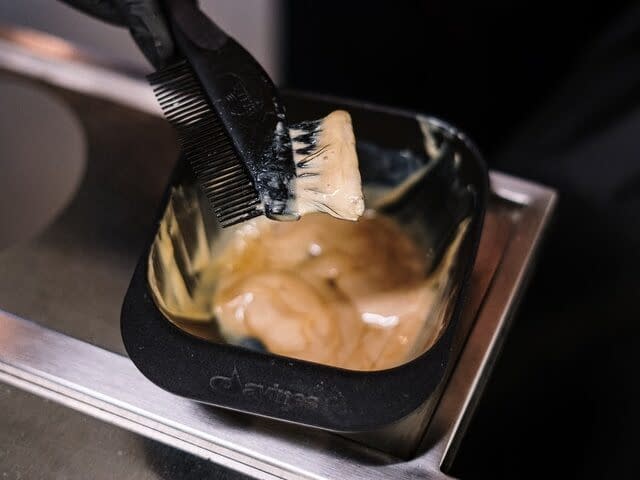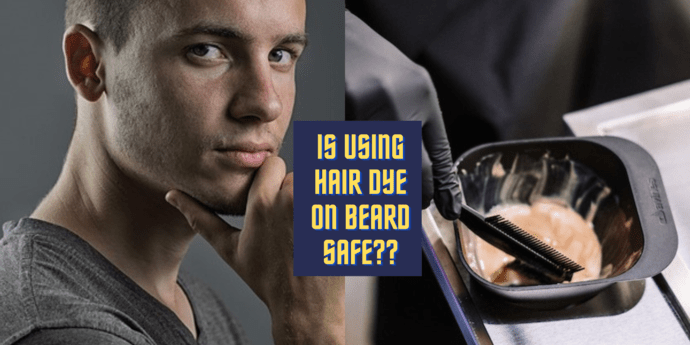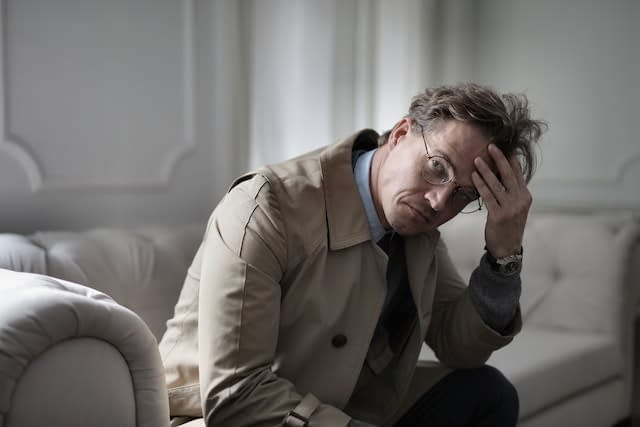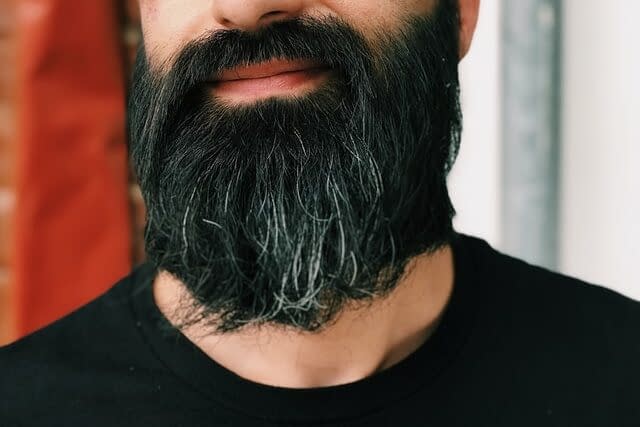People who love their beards know the things they went through to achieve that fuller, thicker beard. Grey hair is one of them which pops up without any specific reason.
There is nothing wrong with flaunting a salt-and-pepper beard, but somewhere it compromises your look. When you can color your hair to look much younger, then why not a beard?
The question always arises in everyone’s mind whether you can use your hair dye on beards.
Yes, you can use hair dyes on your beard, but check the ingredient list before putting any hair dye on facial hair. Hair dye made with natural ingredients like henna will not harm your beard and the skin underneath, whereas chemical-based might affect you.
You must not use the same products on the scalp and the face, as the latter is more sensitive than the former. Some brands recommend using it in both places.
You can use them but do a patch test before applying them all over the face. Also, read blogs: Best beard dye for sensitive skin and how to remove beard dye?
Table of Contents
Difference Between Hair dye and beard dye
As the name implies, hair and beard dye is formulated to use on the hair and the beard, but they both are minimally different.

Hair dye consists of more harsh chemicals than beard dye. The reason is scalp hair is thicker and more resilient than facial hair.
It penetrates deeper into the hair shaft, making it long-lasting and resistant to washing out.
On the other hand, beard dyes are gentle and less irritating than hair dyes. Beard dye usually has natural ingredients like henna or indigo, which makes it suitable to use on the face.
It is also possible to apply hair dye for a longer period of time, and it also lasts longer than beard dye.
To avoid skin irritation or other side effects, use a product specifically formulated for the type of hair you are coloring and follow the instructions carefully.
Is using hair dye on my beard safe?

Frankly speaking, it depends!
It depends on the hair dye, ingredients, brand, skin conditions, and sensitivity. Some dye brands allow you to use their hair dye on beards and mustaches, but some specifically mention the particular use.
So before anything else, I would like to brief you about the types of body hair and why we must use the product specifically made for the hair or face.
The three types of body hair are terminal, vellus, and lanugo.
The terminal hair, or the hair found on our head, is the strongest, thickest, and coarsest hair than the rest.
Vellus hair is the hair on our face that is soft, thin, and more sensitive than terminal hair. At last, lanugo hair is the most delicate hair found on the neck and many other body parts.
Brands that design dyes for terminal hair use harsh or potent chemicals that will not affect hair or scalp. But since facial skin and beard are sensitive and delicate, these products can affect that area.
On the other hand, beard dye sometimes has less or no chemicals that make it suitable for facial hair and prevent skin conditions.
Beard or hair dye might have almost similar ingredients as both are doing the same task, but their ratios are different.
On the safer side, avoid using hair dye on your beard because hair dyes have strong chemicals that can ruin your skin.
Beard dyes are safe to use but try to find the one made with henna. It will cause no side effects.
For sensitive skin, use a temporary beard pencil or pen filler. You can get a similar experience without any effect.
Risk of using hair color on beard:
Hair dye on a beard can be safe if it has henna or other natural ingredients. Some brands offer to use the same hair color on your beard too.
But if your hair color has chemicals or ingredients that can be harsh on facial skin, the following risk can occur:

Beard dermatitis:
According to the report, para-phenylenediamine (PPDA) is one of the active ingredients in hair dyes. PPDA can cause contact dermatitis to the one who uses it on the scalp or hairdresser.
When Arab men used these hair dyes on their beards suffered beard dermatitis and faced pruritic, erythematous, papular eruptions in the jaw area.
After discontinuation and topical medication, they tend to recover it.
The above report suggests that hair dyes on the beard can be dangerous and cause beard dermatitis.
Chemical burn:
Applying hair dye, bleach, or any other chemical-based product for longer than recommended can result in chemical burns.
You may suffer rashes, redness, itching, and soreness due to chemical burns.
People usually leave the dye for more than the time recommended to enhance the intensity of color. As a result, they suffer chemical burns.
There are already potent chemicals in hair dye, and even if you apply it on your beard for a short period, less than the manufacturer recommends, you can experience chemical burns.
I recommend going natural or keeping visual on timings, or you may suffer a chemical burn.
Hair breakage and thinning:
Most hair dyes have ammonia and hydrogen peroxide(bleaching agent) that loosens the hair in the telogen phase, weakens the hair shaft, and leads to hair breakage.
Using hair dye on a beard can do the same. It makes each hair strand weak and thin and causes hair breakage.
You may not observe the instant effects of hair dye, but its continuous use can eventually damage hair and fall out.
I recommend going with beard dyes with gentle ingredients than hair dyes.
Allergies:
According to Healthline, hair dyes can cause mild to severe conditions like stinging or burning sensation on the scalp, face, or neck,
blisters or welts, scalp and face itching or swelling, red rash,
swollen eyelids, lips, hands, or feet.
Some rare reactions include trouble breathing, fainting, nausea, vomiting, throat and tongue swelling, and skin reactions like stinging, burning, swelling, and rashes on the body.
When hair dyes can cause a reaction on the scalp, you can calculate the effect on the face(more sensitive than the scalp).
Things you must consider before purchasing dye for facial hair
Whether you are going with beard dye or hair dye for a beard, make sure you are considering the below points to keep any risk at bay.

Ingredients:
The ingredient of any product says a lot about whether it will react or benefit. It is one of the crucial factors when choosing a beard or hair dye.
Usually, hair dye has potent chemicals like para-phenylenediamine (PPDA), paraben, sulfate, fragrance, and many others.
Beard dye has fewer or gentle chemicals that will not react with your skin.
When you select a beard or hair dye, flip the back and read all the ingredients. If it has any dangerous chemicals or artificial ingredients, avoid purchasing it.
Always try to choose an organic, herbal, and natural product. There is the possibility it might not work but will also cause no harm.
Natural hair dyes like Grizzly Mountain Beard Dye are a perfect example of herbal dyes with natural ingredients like fresh Emblic, False Daisy, Neem Tree, Henna, and indigo.
Brands:
Always go with branded, affordable hair dyes. The thing is, you cannot put any random dye on your face. There must be trust before using any product.
The best part of going with branded dyes is they are reliable. Thousands of people have already used them (so you can read their reviews or learn from their mistakes).
Also, you can get all details regarding the manufacturer and ingredients so you can trust their quality.
Type of dye:
There are three types of hair dye: permanent, temporary, and semi-permanent.
The permanent dye lasts longer than the two and has the most potent chemicals. Semi-permanent will last for a few weeks but also has chemicals.
Temporary dyes or beard pen/pencil is a great way to hide beard patches or a thinner beard. It might have chemicals but way less than the remaining.
If you have sensitive skin, temporary dye is the best way to hide or fill beard patches. Also, it will keep you away from harmful chemicals.
Color:
Choosing the right color is way crucial. If you have a darker or lighter tone, you may get rid of it but at what cost? You need to apply more chemicals to improvise them.
People usually keep lighter tone dyes for more than the recommended time to get their desired darker beard, which causes chemical burns and allergies.
So, before purchasing any shade, decide which one will suit you and look natural.
Price:
Do not run for expensive beard dyes. It may or may not suit you. Be sure to look at the ingredient list before using a product to ensure the suitability of your skin type and appearance.
If your budget is tight, go for the temporary dyes, they are affordable, chemical-free, and help you with your looks.
How to darken your beard naturally?
Using hair dye on a beard may or may not harm you, but if you use natural beard dye, there is a low chance of getting harmed.
Natural dye might not last as long as hair dyes, but it will never harm you until you have an allergy.
Here I have five simple steps to darken your beard naturally at home with minimal investment.

Choosing a natural beard dye:
So here we have a few options if you want to color naturally and free of harmful chemicals:
Henna:
Henna is a natural plant-based dye used for centuries to color hair, skin, and nails.
When it comes to beard dyeing, henna is a popular choice because it not only adds color but it also conditions and strengthens the hair.
It comes in powder form. All you need is to mix it with water to form a paste. You can soak it overnight in an iron pan with black tea.
Coffee:
Coffee contains pigments that can darken the beard, but it is not a reliable or effective method for coloring hair.
It may temporarily darken hair due to the natural pigments it contains, but the results may not be consistent and may wash out in a few days.
Brew a strong cup of coffee and allow it to cool. Mix it with either a bit of leave-in conditioner or use it directly on the beard.
Black tea:
Black tea contains tannins that help to darken hair or beard naturally. However, the effects of black tea on hair will depend on the natural hair color and texture.
Brew a strong cup of black tea and allow it to cool. You can directly use it on hair or beard without mixing it with any ingredient.
Onion skin:
Onion skin has been used for centuries as a natural dye for coloring hair and fabric.
The pigments in onion skins, known as anthocyanins, can impart a range of colors from yellow to orange to reddish-brown, depending on the method and concentration of the dye.
However, it is crucial to note that using onion skin as a hair dye may not provide consistent results, and the color may fade on some days.
Additionally, onion skins may cause irritation or allergic reactions in some individuals.
Boil onion skins in water for about 30 minutes. Strain the liquid and allow it to cool.
Walnut shells:
The outer husk of the walnut contains a pigment called juglone, which can impart a range of colors from light brown to dark black, depending on the method and concentration of the dye.
The results may not be as consistent or long-lasting as synthetic dyes, and the color may fade soon.
Crush walnut shells and boil them in water for about an hour. Strain the liquid and allow it to cool.
Patch test:
Doing a patch test is crucial because sometimes you are unaware of your allergies and the kind of pigment you get from the dyes.
- Apply any above solutions to the strands of your beard and the skin.
- Leave it for 20-30 minutes and analyze any irritation, rashes, redness, or inflammation in that area.
- If so, discontinue the use. Also, check the color you are getting after dyeing.
Application:
The best part of natural dye is you do not need any brush or tools to apply them properly. You can spray them or apply them using a cotton ball.
Apply the henna or the above liquids to your beard and leave it on for at least an hour.
Cleansing:
After an hour of application, you can rinse it with normal water. Also, you can apply beard shampoo and conditioner after that.
Conclusion:
Hair dye on beards is a good idea only if you have natural dyes like henna, coffee, walnut, etc.
Other market-based hair dyes have potent chemicals that can ruin your beard. Harsh chemicals can affect the thickness and natural skin moisture of the beard.
You can use beard dye specifically made for facial hair as they are gentle than hair dye and has fewer chemicals.
If you still want to use hair dye on your beard, as some brands recommend, do not forget doing, proper research and read reviews about its ingredient and other factors.
FAQs:
How long does to leave hair dye on the beard?
First of all, do not use hair dye on your beard but beard dye instead. Both costs are almost similar. The best is to go natural. If you still want to apply hair dye on your beard, keep it for not more than 20 minutes. The package itself tells you how long you must keep it. On the safer side, keep it a little less than recommended.
How long does beard dye last?
Beard dyes are generally semi-permanent dyes that last for 3-6 weeks. The natural dye for beards, like henna, can last up to 4 weeks, and others less than two weeks.
Can I use Just for men hair dye on my beard?
Use Just for men’s beard and mustache dye instead of hair dye. Beard dyes are gentle than hair dye and will cause no harm to your skin.
Kayden is an entrepreneur, writer, hairstylist working in a professional salon. He specializes in men’s grooming. He loves to blog about beards, hairstyles, and skincare.